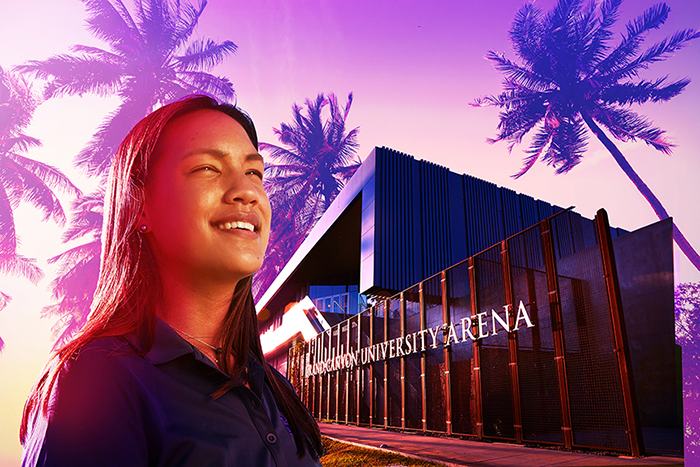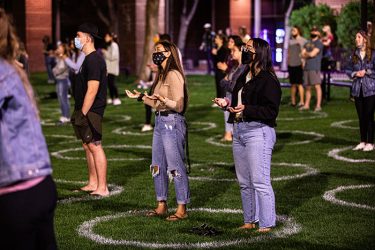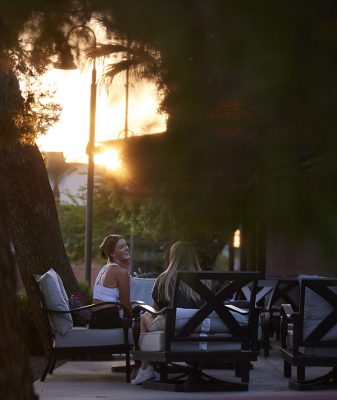
Editor's note: Reprinted from the April issue of GCU Magazine. For the digital version of the magazine, click here.
By Mike Kilen
GCU Magazine
Grand Canyon University didn’t wallow in pandemic self-pity.
For a year, its staff and students made the best of it while hoping and planning for a bright light at the end of the tunnel.
Well, get your sunglasses.

You almost can hear the horns honking and music playing for Welcome Week, which marks the return of students moving into residence halls. You almost can see collective hands raised in Chapel worship and sports contests in the Arena and in full classrooms.
After a year of sacrifice and adjustment, the Lopes will be back. At least that’s the back-to-normal plan for fall, God and viruses willing.
“I’m looking forward to seeing faces again. Faces at GCU are so warm and welcoming,” said Jard Cassell, the reigning Mr. GCU, who will be a senior. “I love seeing people’s smiles as they walk around and talk. I’m ready for that normalcy.”
He was standing on the lawn of the Quad, where painted circles marked the 6-foot social distancing for events there. Those circles are a grim reminder of safety campus protocols that may be a part of history, depending on developments of COVID-19 and the vaccinations in the coming months.
But during the year, GCU leaders weren’t idly hoping for a return to the way it was. They worked hard to make GCU better.
Several new academic programs were launched to start in the fall, many that are directly tied to ways society has changed over the past year.

A new, innovative student living community called The Rivers steadily rose off Missouri and 29th avenues, stretching the bustling 275- acre campus farther east and highlighting the indoor-outdoor nature of a sunny University campus that came into focus during the pandemic.
There will be more new places to eat on campus and more to do.
And there also will be new energy among people.
“I don’t really think I learned how to live my life to the fullest until I was able to look back on this year,” junior Grace Reich said.
COVID was disconnecting her from people, politics were divisive and she struggled mentally. She found that people sank deeper into a life of looking at their phones. So she made it her mission to meet one new person every day, a lesson she will take into her senior year.
“I’ve met so many more people this year than ever before. And now that things will be back to normal, or a new normal, I think it is time for us to come even closer and really stress those mental health issues,” she said.
We learned a lot over the past year in many ways that could make the fall even better.

University Provost Dr. Hank Radda said the pandemic provided lessons about the value of synchronous learning, and cameras in classrooms will stay as a new flexible option. It also allows for opportunities for more outside speakers to join the classroom.
“We found that with conferences we ran, you could get one headline speaker. But now you can get the best and the brightest from all over the world,” Radda said.
They also learned from a year of COVID that starting classes in late August didn’t make as much sense as starting after Labor Day – on Sept. 7 in the 2021-22 academic year. And with the growing prowess of online instruction during the pandemic, offering classes online the week of Thanksgiving will be seamless.
But there is a hunger for meeting face to face again in classrooms, where new programs were launched at a unique time in history as some wondered how to help each other through the wake of crisis and how to highlight the truth in a time of disinformation.
The bachelor’s degree in Social Work joins the growing offerings in that discipline, which include a master’s in Social Work that concludes its first full year.

“You look at what is happening in the world and it’s a good time, not that it wasn’t needed before,” said Dr. Kathleen Downey, Director of Social Work. “The world is changing and so is the awareness of other people; there’s a need to accept people for who they are.
“The social work profession advocates for the vulnerable populations, especially right now as the world changes. When change happens there is always pushback and sometimes that pushback requires advocates – and the heart of what social work does is advocacy.”
It’s also tightly fit into the mission of GCU as a university centered on Christianity, where social work began, she said.
Other cultural changes that came into focus during a pandemic and an election year are related to new academic programs on media in the College of Humanities and Social Sciences (CHSS) and College of Fine Arts and Production (COFAP).
A Bachelor of Arts in Professional Writing in New Media is needed now for students to become communicators who tell truthful, powerful stories of the world around them, said Kimbel Westerson, a CHSS instructor.
“That’s what writers are — storytellers,” she said.

And that relates to GCU’s goals of revitalizing its own neighborhood.
“Look at where the students are, out there helping with Habitat for Humanity, volunteering at St. Mary’s Food Bank. They see what is going on in the West Valley neighborhood and they want to tell those stories,” she said.
In Communications, three new emphases were added – Broadcasting and New Media, Political Campaigns and Interpersonal Communication and Human Relationships. Add the new COFAP undergraduate degree in Social Media, and GCU students can be part of the solution to problems of disinformation and negativity that seemed to accelerate during the past year.
“At GCU, we want our students to be the voice of reason at that table of conversation, so they can ask, ‘Have we thought of the consequences of this, have we been empathetic to all the stakeholders who want to receive this message?’” said Sheila Schumacher, Director of Digital Design Programs who oversees the Social Media program in COFAP.
That’s not all. The Cyber Center of Excellence will move to a new location in the Technology Building, closer to the center of campus. Instructors will be closer and the labs more accessible.
“Students will be able to stop by between classes or during lunch break and knock out labs or even try their hand at some network cracking,” said Khester Kendrick, faculty in the College of Science, Engineering and Technology. “This new state-of-the-art facility will place GCU as a premier information technology and cybersecurity provider.”
And because of the new upheaval with pandemics and natural disasters, the demand grows for more risk managers and insurance adjusters. GCU’s new Risk Management Program will address that need.

“We keep seeing these events you never thought you would ever see happen,” said Mark Jacobson, finance chair in the Colangelo College of Business. “How do you manage that or survive that as a business? Companies are building risk departments.”
Jacobson said the program will put GCU at the forefront in Arizona and among the leaders in the western United States.
But it’s not all about academics.
Students are yearning for a new outlook on life on campus.
“And not living scared,” said Chris Kirk, who will be a senior in the fall. “This whole year just makes you think about other people more.”
Leaders of student government think it also helped students learn how to make strong connections with each other.
“It really shined a light on how if you only make 10 valuable connections, you really invest in those,” said Darion Padilla, incoming President of the Associated Students of Grand Canyon University.
The year was also one of turmoil in race relations on a national level, and he hopes to grow those connections between students by joining with other organizations on campus for events, including the Multicultural, Diversity and Inclusion Office.
“As a person of color, it’s important that all students of color are valued, but especially students who may be in the minority,” he said.
Students say that sense of a unified community is a valuable part of the GCU experience, and it’s often borne of large events that had to be downsized this year.

Assistant Dean of Students Danielle Rinnier said the University is looking forward to holding big events, such as those for Welcome Week, popular student events such as Mr. GCU and Lip Sync, athletic contests and Chapel.
But they learned from the pandemic that the adaptations this year added possibilities, too, such as smaller, outdoor venues for student spiritual gatherings.
“That is what is great about Arizona and why they come to live here. It’s nice outside and you want to be outside,” she said.
Director of Spiritual Life Braelyn Armenta said those experiments with occasional outdoor worship likely will be continued during the fall.
“It’s nice to have a scaled-down experience outside with nice weather,” she said. “I think students really enjoyed it.”
It’s as if a new awareness was created during the pandemic: GCU is really a great campus, annually ranked in the top 20 in the country by Niche.com and suited for the outdoors.
New outside areas became gathering spaces after furniture was added.
Students gathered on the outdoor furniture in front of Kaibab and at the tables on either side of the new Student Advising Services Building, in the park by Colter Street, in new seating around the Quad and in the green spaces next to the Canyon Activity Center, where yoga classes seemed to stretch into all hours.
“We are going to try to keep that going because, though it’s hot for a couple of months, it’s beautiful the rest of the time,” said James Kossler, Vice President of Facilities Planning and Operations.

Changes in recreation also will continue in the fall. Because Outdoor Recreation Programs limited off-campus trips, it came up with innovative programs on campus, such as gardening and scuba classes, that will continue to be offered because they introduced entire new groups of students to programming, said Matt Lamb, Director of Campus Recreation.
Intramurals added human foosball on the hockey rink and the wildly popular game cornhole. They will be added to the mix when traditional flag football, basketball and softball leagues start up again.
Part of why the GCU campus is so desirable is that recreational facilities are spread equally across the large campus, making them assessible. Adding to that this fall will be a new fitness center in The Rivers, a new student housing complex that rose throughout the year.
Three six-story student apartment buildings – Verde, Salt River and Agua Fria — add approximately 1,800 beds while set up to provide easy interplay between indoors and out. Garage doors will open to the outside in the fitness facility in Verde, for example, and there will be ample courtyards and a pool on the complex.

Salt River will include a large arcade area, and Agua Fria will have the popular student coffee shop hangout, GCBC. A new Panera Bread and Nekter Juice Bar will be part of it, too, after students asked for those eateries. “We have noticed our students leaning toward healthier options,” said Jessica Maichel, Marketing Supervisor for GCU Dining, operated by Sodexo.
It also will be easier to get from The Rivers to the rest of campus to the west because the city of Phoenix granted conditional approval to GCU to take over Georgia Avenue, which the city is expected to abandon by the end of summer, Kossler said.
“The growth of the University continues to be astounding, I would guess unprecedented,” said Matt Hopkins, Director of Residence Life, who has seen a new housing complex open every year since he joined GCU in 2012, growing from six living areas to 26. “(The Rivers) is another opportunity to serve students by providing great living accommodations for them.”
Building toward a normal life on campus is well underway, and there’s no shortage of hope and excitement for the future.
Grand Canyon University senior writer Mike Kilen can be reached at [email protected] or at 602-639-6764.
****
Related content:
GCU Today: New programs connect to communication changes
GCU Magazine: How GCU scored points with pandemic innovations
GCU Magazine: GCU's students on target for campus togetherness















